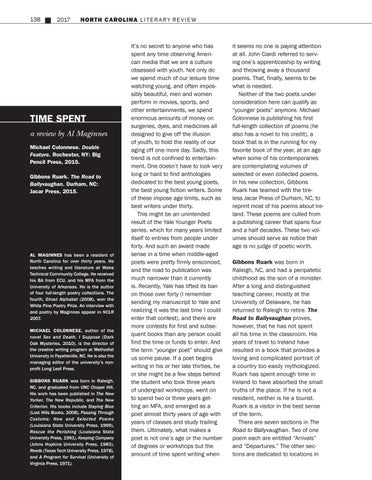138
2017
NORTH CAROLINA L I T E R A R Y RE V I E W
TIME SPENT a review by Al Maginnes Michael Colonnese. Double Feature. Rochester, NY: Big Pencil Press, 2015. Gibbons Ruark. The Road to Ballyvaughan. Durham, NC: Jacar Press, 2015.
AL MAGINNES has been a resident of North Carolina for over thirty years. He teaches writing and literature at Wake Technical Community College. He received his BA from ECU, and his MFA from the University of Arkansas. He is the author of four full-length poetry collections. The fourth, Ghost Alphabet (2008), won the White Pine Poetry Prize. An interview with and poetry by Maginnes appear in NCLR 2007. MICHAEL COLONNESE, author of the novel Sex and Death, I Suppose (Dark Oak Mysteries, 2010), is the director of the creative writing program at Methodist University in Fayetteville, NC. He is also the managing editor of the university’s nonprofit Long Leaf Press. GIBBONS RUARK was born in Raleigh, NC, and graduated from UNC Chapel Hill. His work has been published in The New Yorker, The New Republic, and The New Criterion. His books include Staying Blue (Lost Hills Books, 2008), Passing Through Customs: New and Selected Poems (Louisiana State University Press, 1999), Rescue the Perishing (Louisiana State University Press, 1991), Keeping Company (Johns Hopkins University Press, 1983), Reeds (Texas Tech University Press, 1978), and A Program for Survival (University of Virginia Press, 1971).
It’s no secret to anyone who has spent any time observing American media that we are a culture obsessed with youth. Not only do we spend much of our leisure time watching young, and often impossibly beautiful, men and women perform in movies, sports, and other entertainments, we spend enormous amounts of money on surgeries, dyes, and medicines all designed to give off the illusion of youth, to hold the reality of our aging off one more day. Sadly, this trend is not confined to entertainment. One doesn’t have to look very long or hard to find anthologies dedicated to the best young poets, the best young fiction writers. Some of these impose age limits, such as best writers under thirty. This might be an unintended result of the Yale Younger Poets series, which for many years limited itself to entries from people under forty. And such an award made sense in a time when middle-aged poets were pretty firmly ensconced, and the road to publication was much narrower than it currently is. Recently, Yale has lifted its ban on those over forty (I remember sending my manuscript to Yale and realizing it was the last time I could enter that contest), and there are more contests for first and subsequent books than any person could find the time or funds to enter. And the term “younger poet” should give us some pause. If a poet begins writing in his or her late thirties, he or she might be a few steps behind the student who took three years of undergrad workshops, went on to spend two or three years getting an MFA, and emerged as a poet almost thirty years of age with years of classes and study trailing them. Ultimately, what makes a poet is not one’s age or the number of degrees or workshops but the amount of time spent writing when
it seems no one is paying attention at all. John Ciardi referred to serving one’s apprenticeship by writing and throwing away a thousand poems. That, finally, seems to be what is needed. Neither of the two poets under consideration here can qualify as “younger poets” anymore. Michael Colonnese is publishing his first full-length collection of poems (he also has a novel to his credit), a book that is in the running for my favorite book of the year, at an age when some of his contemporaries are contemplating volumes of selected or even collected poems. In his new collection, Gibbons Ruark has teamed with the tireless Jacar Press of Durham, NC, to reprint most of his poems about Ireland. These poems are culled from a publishing career that spans four and a half decades. These two volumes should serve as notice that age is no judge of poetic worth. Gibbons Ruark was born in Raleigh, NC, and had a peripatetic childhood as the son of a minister. After a long and distinguished teaching career, mostly at the University of Delaware, he has returned to Raleigh to retire. The Road to Ballyvaughan proves, however, that he has not spent all his time in the classroom. His years of travel to Ireland have resulted in a book that provides a loving and complicated portrait of a country too easily mythologized. Ruark has spent enough time in Ireland to have absorbed the small truths of the place. If he is not a resident, neither is he a tourist. Ruark is a visitor in the best sense of the term. There are seven sections in The Road to Ballyvaughan. Two of one poem each are entitled “Arrivals” and “Departures.” The other sections are dedicated to locations in
